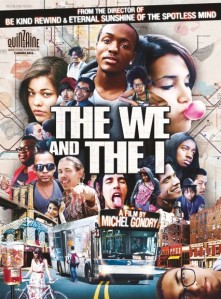If you’re like me, you’ve been waiting for filmmaker Michel Gondry to wow you after his messy miscalculation known as The Green Hornet. In Gondry’s defence, The Green Hornet played as a film where its “it” star and successful producers had more creative control than its masterful director. Gondry’s visions work better when he’s given a fair bit of leeway and trust, and The Green Hornet didn’t allow this for the Oscar winner.
The We and the I is supposed to act as a progressive return to form for the director – and it is. The low budget high school flick is an offbeat hybrid of Kids and Dazed and Confused if Spike Lee served as a creative consultant.
The We and the I is more than fitting for Michel Gondry’s directorial style, writing, and creative mind. It features the best qualities from his more well known work that made him a standout, and he’s able to adapt those strengths in this story about a bus ride home after the last day of school.
The film and its cast have a communal feel which is similar to the movie loving community we watched in 2006’s Dave Chappelle’s Block Party and 2007’s Be Kind Rewind. The amateur actors – who all take on characters who have the same name as them – are likeable and are almost always yapping. Surprisingly, this non-stop jibber-jabber is endearing, honest and adds to the fly-on-the-wall nature of this slice of urban life in New York City. The film has the power to transport you back to when you were in high school eagerly listening – or contributing – to the rumour mill.
The actors may be likeable, but we feel by a few individuals; you’ll know who when you watch the movie. It’s easy to use the “they’re not professional actors” excuse, but that song can be played only so many times. Some students lack so much comfortability in front of the camera that one wonders why Gondry and his casting crew didn’t search for more natural actors who are equally authentic.
Gondry’s storytelling trickery that we saw in 2004’s Eternal Sunshine of the Spotless Mind is also at play. Many stories are told on this long bus ride home. At one point, three of them overlap. Instead of using split screen techniques, Gondry blends in his settings. When a girl is explaining to her girlfriends about a late night hook-up in a car, the car is seamlessly integrated into another story taking place at a party. The camera pans over to the passenger side window and we’re seeing another wild memory take place. It’s a very cool effect and effectively displays how our ears can wander in and out of multiple stories we hear.
The flashbacks are shot on camera phones and more consumer-based cameras. Again, this adds to the fly-on-the-wall perspective but it also conveys that this is probably how other students would’ve seen this event take place if someone was shooting it. All that’s missing is a YouTube engine, but that would’ve been too much excessive product placement – though Blackberry can consider The We and the I as a subtle commercial for their sleek smartphones.
If you took away the smartphones and any mention of technology, The We and the I would be a product of the 90’s even more so with its older hip-hop soundtrack and the lack of heavy modern politically correctness. The kids are pervasively bullying, yet there’s no message that what their doing is considered tasteless. Upbeat music even plays over top of most of these gags. It’s not that Gondry and his team are insensitive. They just want to playfully show that this is what kids might do to amuse themselves amongst their friends. And I dare you not to laugh during a scene when a misplaced cigarette is spotted by the bus driver after the more intimidating bullies are caught smoking at the back of the bus.
It’s all in good fun and we find ourselves having a ball and drinking in the style the film takes on. Even then, the film wears thin as friends gradually get off the bus leading to the material getting more serious. The We and the I has the mentality of a really good party. It’s exciting and joyous when everyone is together and having a great time. But when the party starts to diminish, you soon have a scattered group of people who feel tired and burnt out. Audiences will feel the same.
While The We and the I may still be inferior to Gondry’s past work and music videos, it’s a confident sign that this filmmaker hasn’t lost his touch. It’s an exciting reminder mixed with touching nostalgia that runs a wee bit too long.





Be the first to comment